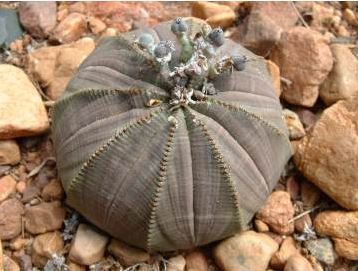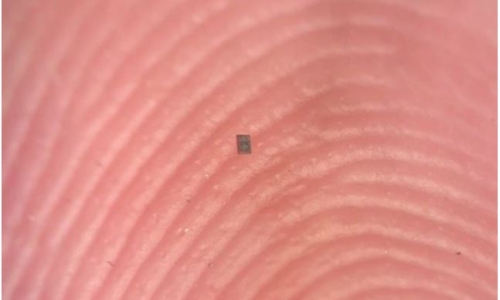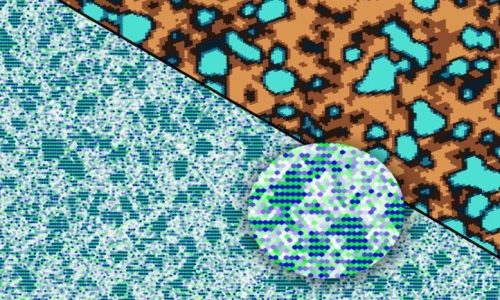


 3:6:44
3:6:44  2023-09-12
2023-09-12  1579
1579

Description
Euphorbia obesa can grow to 20 cm in height with a diameter of 9 cm. It is a single-stemmed, unbranched, firm-bodied plant. The stem is usually 8-angled and grooved, subglobose (almost spherical) in shape, elongating and becoming cylindric as it gets older. Younger plants have a rounded sea urchin-like shape. The rotund stem is mottled grey-green in colour with dull purple transverse bands. It has a tapering tap root. The leaves are very rudimentary and soon drop off.
Euphorbia obesa is dioecious, i.e. male and female flowers occur on different plants. All euphorbias have a complex floral arrangement that is termed a cyathium (a cup) and this is the unit of the inflorescence. A cyathium contains many highly reduced male flowers or a single female flower. In Euphorbia obesa, the cyathia appear in summer, from "circular flowering eyes", situated along the tops of the angles, near the growing tip, on the stem. They are produced on fork-branched peduncles (flower stalks), have minute bracts and are finely hairy. The cyathia are cup-shaped to 3 mm in diameter, expanding in the female. The fruit is a slightly 3-angled capsule, up to 7 mm in diameter that explosively releases small rounded 2mm diameter mottled grey seeds when mature. The peduncles do not persist, and fall off after the seed has been dispersed.
Conservation Status
Euphorbia obesa is a rare endemic of the Great Karoo, south of Graaff-Reinet in the Eastern Cape. Over-collecting by collectors and plant exporters almost resulted in the plant becoming extinct in the wild. Today it is protected by national (Nature Conservation) and international (CITES) legislation.
Although Euphorbia obesa is still rare in its habitat it is well established in cultivation. Hundreds of thousands of plants are produced annually by the horticultural trade in America and Europe. This is an example of ex situ conservation and one can safely assume that more plants exist in cultivation than in the plant's native habitat.
Distribution and habitat
The plants occur in karoo vegetation among Beaufort shale fragments, where they grow in full sun or in the partial shade provided by dwarf karoo shrubs. They are very well camouflaged and difficult to see. The habitat is very stony and hilly with summer rainfall ranging from 200-300 mm per annum, falling mainly in thunder showers. Summers are very hot: the average daily maximum about 26 degrees centigrade and the minimum about 11 degrees centigrade. Light frost occurs during the winter months.
Derivation of name and historical aspects
Professor Peter Macowan (1830-1909), a botanist from Gill College in Somerset East, discovered Euphorbia obesa near Graaff-Reinet in 1897. He collected this peculiar ball shaped succulent plant and sent it to the Royal Botanical Gardens, Kew. It flowered in their succulent house in 1899 when a description was drawn up and the plant named by Joseph Dalton Hooker (1817-1911). Today it is one of the most sought after succulent plants of South Africa.
The genus Euphorbia was established by Linnaeus in 1753 and commemorates Euphorbus, the 1st century physician to King Juba II of Mauritania, who is thought to have used plants, such as euphorbias, as medicine. It is a large genus and consists of about 2000 species. Not all are succulent. Of the ± 270 species that occur in South Africa almost 200 (74%) are succulent. Euphorbias are widespread in southern Africa, ranging from the north to the south, east to west, from the coast to the high Drakensberg escarpment and Lesotho. They vary from dwarf plants a few centimeters high to large trees such as the naboom, Euphorbia ingens that can grow up to 15 m tall. Most succulent euphorbias are common in the semi-arid parts of South Africa. The Eastern Cape is especially rich in Euphorbia species. Most of these make splendid garden subjects and are excellent for the hot, dry garden. Euphorbias have a milky latex which is poisonous and is especially irritant to tender or cut skin and the eyes and all plants should be handled with care.
Growing Euphorbia obesa
Euphorbia obesa is best grown as a pot plant in a sunny position such as a window sill or stoep (verandah) but can also be grown out of doors in the Karoo and other desert gardens where frost is not too severe. It does best in a gravely shale based soil, but is tolerant of a wide range of soil types. Good drainage is essential. Water sparingly during the summer months and keep dry in winter. It is a slow growing long lived plant and once established, it will be content in its position and with its soil for years. It can tolerate moderate shade, and a plant that has been growing in shade should be slowly hardened off before placing it in full sun as the plant will be severely scorched if moved too suddenly from shade into sun.
Euphorbia obesa is easily propagated from seed sown during spring or summer. Sow in a sandy to gravel-rich, well drained potting soil in a sunny warm position and in a standard seed tray. Cover seed with a thin layer of sand (1-2 mm) and keep moist. Germination occurs within 3 weeks. The seedlings have a slow to medium growth rate and can be planted out into individual bags as soon as they are large enough to handle. Flowering can be achieved within 5-8 years. Plants can be hand pollinated with a small paint brush. Rub pollen onto the brush and transfer to stigmas of female plants. Remember to cover the female plants with a stocking or a net to catch the seeds, otherwise the capsules will shoot them far and wide.
Reality Of Islam |
|

A tiny robo

By applying

Stanford, C
 9:3:43
9:3:43
 2018-11-05
2018-11-05
10 benefits of Marriage in Islam
 7:5:22
7:5:22
 2019-04-08
2019-04-08
benefits of reciting surat yunus, hud &
 9:45:7
9:45:7
 2018-12-24
2018-12-24
advantages & disadvantages of divorce
 11:35:12
11:35:12
 2018-06-10
2018-06-10
 6:0:51
6:0:51
 2018-10-16
2018-10-16
bahlool & the throne of haroun rashid
 8:20:35
8:20:35
 2018-06-21
2018-06-21
 4:26:43
4:26:43
 2022-02-21
2022-02-21
 2:42:26
2:42:26
 2023-02-02
2023-02-02
 8:21:9
8:21:9
 2018-06-21
2018-06-21
 1:16:44
1:16:44
 2018-05-14
2018-05-14
 9:50:37
9:50:37
 2023-02-28
2023-02-28
 11:2:27
11:2:27
 2022-10-06
2022-10-06
 5:41:46
5:41:46
 2023-03-18
2023-03-18
| LATEST |